We all know that the Earth is spherical (not exactly, byt
close enough for my purposes here). But what world maps seem
to tell us is that is more like a cylinder. Wider at the
equator, though – barrel-shaped perhaps?
Why, just look at the map:
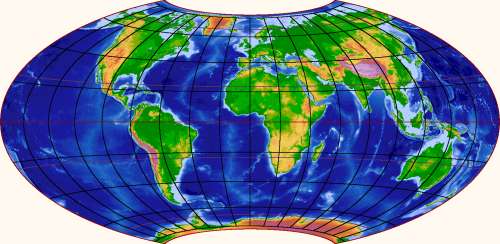
We know that the left and right edges are really the same
place; there is only one Pacific Ocean. It's not too unusual
either to have seen maps where the edge is some meridian other
than 180° E/W, such as this:
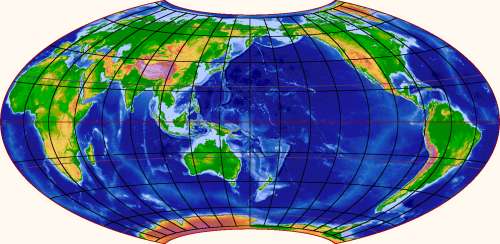
So we're familiar with the fact that if we keep moving east or west
long enough, eventually we'll end back where we started. This
striking enough that circumnavigating the globe is considered
something in and of itself (Phileas Fogg never ventured south
of the Equator, but is nevertheless considered to have gone around the
world). But it does not feel strange, as such.
The poles, however, are weird. In the projection I have chosen
here, each pole has been deformed from a point into a curve
that forms the entire top or bottom edge of the map. We know,
intellectually, that this is just a coordinate singularity, an
artifact of the map projection. To someone actually standing
on the pole, the ground will appear just as flat and featureless as
it does anywhere else, modulo mountain ranges and other minor details.
But knowing is not the same as really believing. We feel vaguely
– or perhaps I should stop speaking for everyone else at this
point – I feel vaguely that this coordinate weirdness
somehow must correspond to a real weirdness, that if I were to go
there I would somehow distort along with the map, like the proverbial
gedankenastronaut who falls into a black hole and finds himself
stretched by infinite tides in the east-west direction.
A more everyday symptom of barrel-shaped thinking is the surprise
we've all felt at some point noticing just how close to the pole a
great-circle route between two distant cities goes. If you fly from
London to Tokyo, the standard maps invite the assumption that you
should head to the east and slightly south. But actually you should
start out in a northeastern direction and pass quite close by
Helsinki.
I set out to disabuse myself of the barrel-shaped fallacy.
The first step is to look at a map which does not distort the
poles – a pole-centered azimuthal projection:
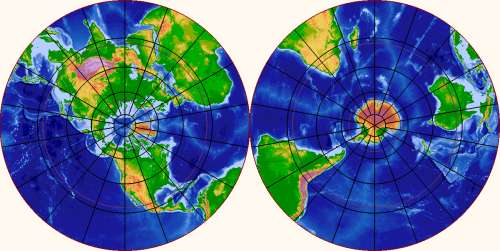
This helps a bit, but not by much. The coordinate lines of the
polar map still implicitly convey the message that the pole is a
very special place. There's still a feeling that it has some
momentous topological significance whether a path from point A to
point B passes left or right of the the pole.
Perhaps I just lack imagination, but I still find myself
thinking in barrels when I look at a pole-centered map. Map globes
are not much better; they tend have bearings and other special
decorations at the poles which fuel the barrel fallacy directly.
Stronger measures are needed here. The trouble seem to
be the map grid – how about we draw a completely different grid
over the polar regions? We could pretend that the Earth's axis passed
through, say, Hawaii, and draw the world map that would result.
That sounds promising. More significantly, it sounds fun. So I
wrote myself a program to draw world maps with alternative positions
of the poles. I find the results convincing and fascinating.
Here is the pole-at-Hawaii scenario, with two different central
meridians:

The antipode to Hawaii proves to be in southern Africa, so that
is where the other pole goes. The shape of Africa gets strangely
distorted by the map projection, which should teach us to doubt what
normal world maps tell us about the polar areas. The other continents
look more recognizable, except – wonder of wonders! – the
Arctic Sea is now clearly just another place.
The fascinating part comes from wondering: If the world was
actually tilted to turn around the Hawaii axis (but otherwise with its
current orbit and axial tilt), which climate would such a world have?
Latitudes give a crude hint at the weather at different places, but
that is far from the whole story. Sea currents transport large amounts
of heat around the globe, and the currents would be vastly different
on the tilted globe, driven as they are by winds and Coriolis
forces. The winds themselves would be different; winds try to align
more or less with latitudes but are deflected by mountain ranges and
warped by differences in sea temperatures (which are themselves
governed by currents, which are driven by winds, making the whole
thing recursive). I cannot even start to answer the climate question,
but I'm sure a good answer would be very interesting.
After climate comes culture. How would world history have unfolded
on the tilted globe? For example, this world does not seem to need a
Columbus. What, if anything, would that change? Would the Industrial
Revolution still happen in a tropical, upside-down Britain? I suspect
there's some pretty cool alternative-history fiction waiting to be
written here.
There's no reason to stop at Hawaii, of course. After creating my
program, I have (mis)spent several nights looking around for
interesting places to put the poles. Here is one that shows all of
the continents are connected:
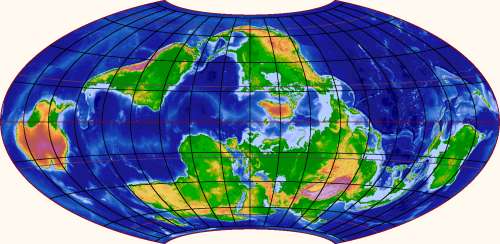
This map has the nice feature that no continental land or shelf is
bisected by the edge. That is not not trivial to achieve because the
edge of a world map of a somewhat orthodox shape must represent half a
great circle, and there isn't much wiggle room to place it without
hitting land. I think there are only three essentially different
solutions; here is a second one, showing continents in a circle around
the Pacific Ocean:
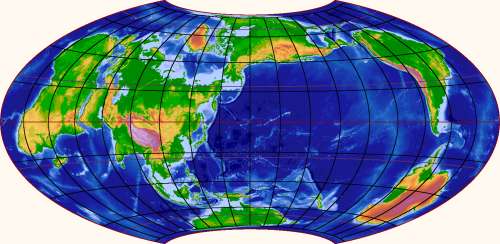
On the other hand, getting both poles to be covered with land is even
harder. The best possibility seems to be this, which just barely does the
trick:
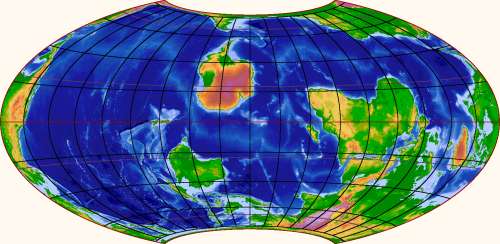
Note here in particular that the only "wet" passage through the
edge of the map is the Bering Strait (save for the wiggliness of the
Panama isthmus, which the straight edge cannot quite follow). This map
tries to tell you that all of the oceans are really just a single sea
surrounded by land. The previous two ones try to tell you that the
continents are really just a group of islands on a water planet. Both,
however, show the same planet. We shouldn't believe any single map too
much.
P.S. I got the shapes of continents, with elevations and sea depths
as a bonus, from the ETOPO2v2
dataset, which is a marvelous
resource. My only regret is that I can't drain away the
icecaps of Antarctica and Greenland, but it's not obvious how to
define the result of that. And it is free! You too can create cool
alternative world maps if you know a programming language and some
spherical geometry.
![[My letter to RBS]](http://henning.makholm.net/blog/images/rbs12small.png)

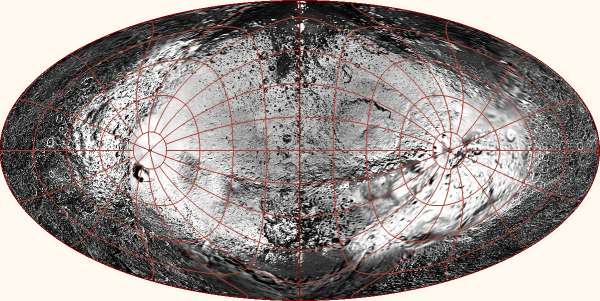
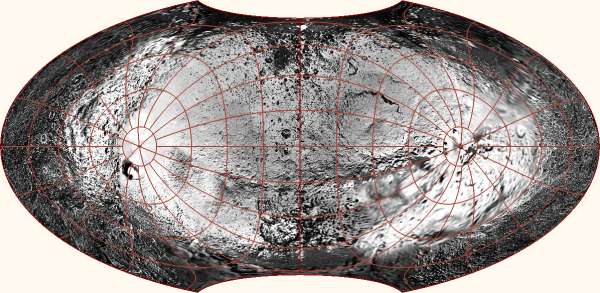
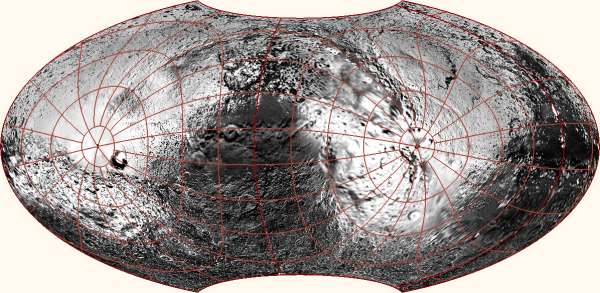
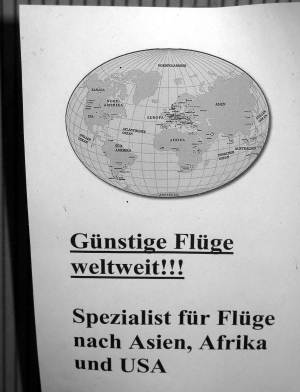
 P.S. It just now occurs to me that
one of the symbols I use in
my hand-drawn sketches, a stylized tree meaning roughly "these
tracks are visibly abandoned; shrubs and small trees growing between
the rails", could easily be interpreted as a stylized mushroom cloud.
Good thing my notes did not fall into the hands of an alarmist
terrorist hunter. Except in 2007 I did foolishly forget a sketchpad in
a train (and lost several days' worth of sketches). Wonder what
happened to that ...
P.S. It just now occurs to me that
one of the symbols I use in
my hand-drawn sketches, a stylized tree meaning roughly "these
tracks are visibly abandoned; shrubs and small trees growing between
the rails", could easily be interpreted as a stylized mushroom cloud.
Good thing my notes did not fall into the hands of an alarmist
terrorist hunter. Except in 2007 I did foolishly forget a sketchpad in
a train (and lost several days' worth of sketches). Wonder what
happened to that ...










 Henning Makholm is a computer scientist and software developer living in Copenhagen, Denmark. Find out more about him on his
Henning Makholm is a computer scientist and software developer living in Copenhagen, Denmark. Find out more about him on his